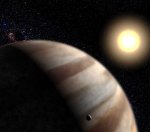Astronomers discover atmosphere around exoplanet
Posted: Tue, Nov 27, 2001, 6:01 PM ET (2301 GMT)
 Astronomers announced Tuesday that they have for the first time detected an atmosphere around an extrasolar planet. Observations of the star HD 209458 by a spectrograph on the Hubble Space Telescope revealed that a planet that closely orbits the star has an atmosphere and is almost certainly a gas giant like Jupiter. The discovery was possible because the exoplanet transits, or passes directly between the Earth and star; light from the star passed through the planet's atmosphere, carrying a spectral signature of the atmosphere's components. Hubble's spectrograph was able to detect sodium, a trace gas in the planet's atmosphere that is easily identifiable. Hubble found about half as much sodium as expected: this may be explained by a high cloud deck blocking light from the lower atmosphere or the reaction of sodium with other elements to form more complex molecules. While the discovery is not surprising, since astronomers had assumed that the planet was a gas giant, it does prove that the technique is able to probe the atmosphere of exoplanets. Currently only this planet, HD 209458 b, is known to transit its star, but up to 10 percent of "hot Jupiters" — gas giants that orbit very close to stars — could eventually be studied using this technique.
Astronomers announced Tuesday that they have for the first time detected an atmosphere around an extrasolar planet. Observations of the star HD 209458 by a spectrograph on the Hubble Space Telescope revealed that a planet that closely orbits the star has an atmosphere and is almost certainly a gas giant like Jupiter. The discovery was possible because the exoplanet transits, or passes directly between the Earth and star; light from the star passed through the planet's atmosphere, carrying a spectral signature of the atmosphere's components. Hubble's spectrograph was able to detect sodium, a trace gas in the planet's atmosphere that is easily identifiable. Hubble found about half as much sodium as expected: this may be explained by a high cloud deck blocking light from the lower atmosphere or the reaction of sodium with other elements to form more complex molecules. While the discovery is not surprising, since astronomers had assumed that the planet was a gas giant, it does prove that the technique is able to probe the atmosphere of exoplanets. Currently only this planet, HD 209458 b, is known to transit its star, but up to 10 percent of "hot Jupiters" — gas giants that orbit very close to stars — could eventually be studied using this technique.
 Astronomers announced Tuesday that they have for the first time detected an atmosphere around an extrasolar planet. Observations of the star HD 209458 by a spectrograph on the Hubble Space Telescope revealed that a planet that closely orbits the star has an atmosphere and is almost certainly a gas giant like Jupiter. The discovery was possible because the exoplanet transits, or passes directly between the Earth and star; light from the star passed through the planet's atmosphere, carrying a spectral signature of the atmosphere's components. Hubble's spectrograph was able to detect sodium, a trace gas in the planet's atmosphere that is easily identifiable. Hubble found about half as much sodium as expected: this may be explained by a high cloud deck blocking light from the lower atmosphere or the reaction of sodium with other elements to form more complex molecules. While the discovery is not surprising, since astronomers had assumed that the planet was a gas giant, it does prove that the technique is able to probe the atmosphere of exoplanets. Currently only this planet, HD 209458 b, is known to transit its star, but up to 10 percent of "hot Jupiters" — gas giants that orbit very close to stars — could eventually be studied using this technique.
Astronomers announced Tuesday that they have for the first time detected an atmosphere around an extrasolar planet. Observations of the star HD 209458 by a spectrograph on the Hubble Space Telescope revealed that a planet that closely orbits the star has an atmosphere and is almost certainly a gas giant like Jupiter. The discovery was possible because the exoplanet transits, or passes directly between the Earth and star; light from the star passed through the planet's atmosphere, carrying a spectral signature of the atmosphere's components. Hubble's spectrograph was able to detect sodium, a trace gas in the planet's atmosphere that is easily identifiable. Hubble found about half as much sodium as expected: this may be explained by a high cloud deck blocking light from the lower atmosphere or the reaction of sodium with other elements to form more complex molecules. While the discovery is not surprising, since astronomers had assumed that the planet was a gas giant, it does prove that the technique is able to probe the atmosphere of exoplanets. Currently only this planet, HD 209458 b, is known to transit its star, but up to 10 percent of "hot Jupiters" — gas giants that orbit very close to stars — could eventually be studied using this technique.
Related Links:
| <<previous article | next article>> |
|
news in brief
|
|
Roscosmos replaces cosmonaut on next Crew Dragon mission to ISS
Posted: Sat, Dec 6 9:45 AM ET (1445 GMT) |
|
news links
|
|
Monday, December 15
Satellites help tackle landfill methane leaks
ESA — 4:46 am ET (0946 GMT) SpaceX adds 27 satellites to its growing Starlink constellation
UPI — 4:45 am ET (0945 GMT) STMicro has shipped 5 billion chips for Starlink in past decade; that could double by 2027
Reuters — 4:44 am ET (0944 GMT) Hegseth Visits Alabama to Cement Redstone Arsenal as Future Home of Space Command
Air and Space Forces Magazine — 4:43 am ET (0943 GMT) RocketLab sends Japanese communications satellite into orbit
UPI — 4:42 am ET (0942 GMT) |